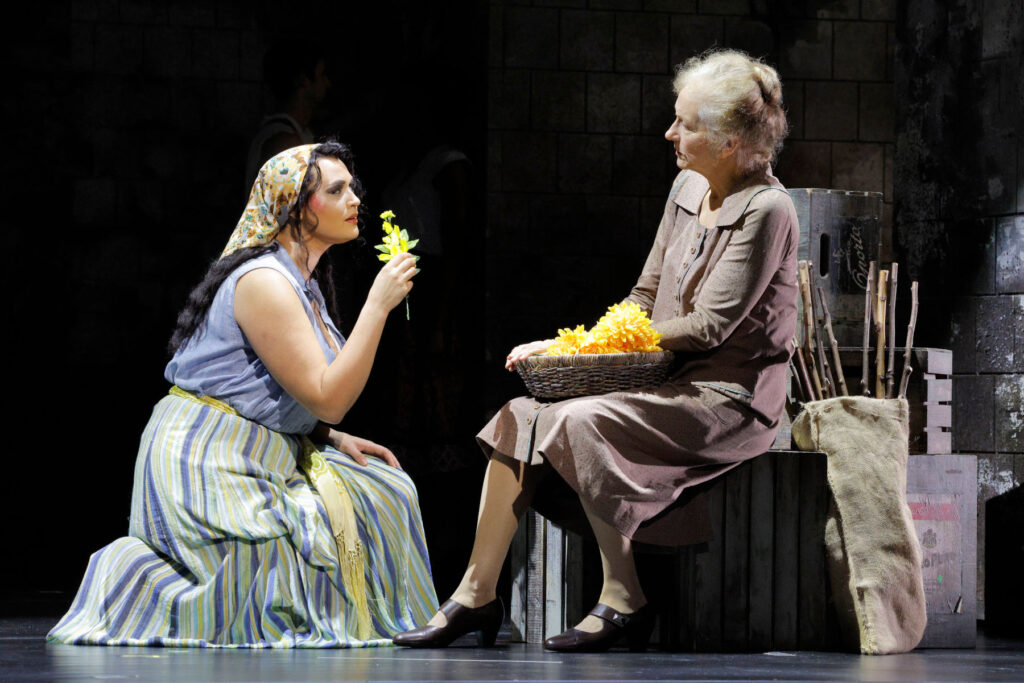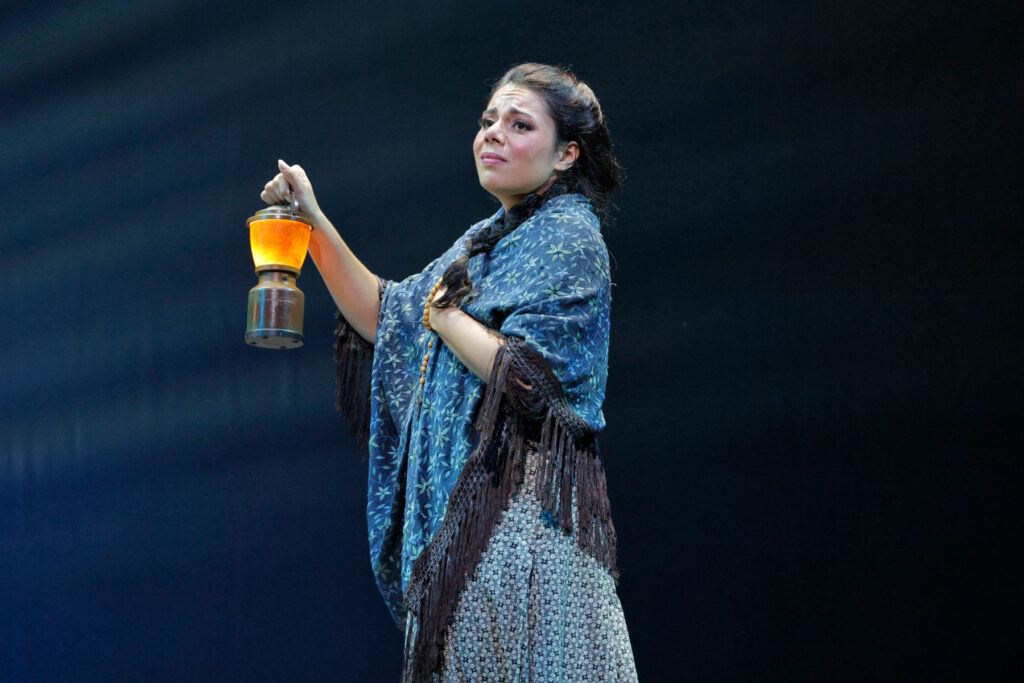It felt appropriate walking up to Wolf Trap’s Filene Center on a sweaty August night for this one-night-only performance, considering that Bizet’s Carmen takes place in southern Spain. It’s a favorite local venue due to lawn seating, where patrons can enjoy picnics, including wine and beer, with their opera. This makes for a reliably enjoyable experience regardless of the opera that’s playing.
Due to the outdoor venue, the orchestra and soloists need to be amplified. Though the idea of amplification is anathema to opera purists and sometimes distracting, in this case, fortunately the amplification was not distracting and it was clear the technical team did their best to make everyone sound great.

The jumbotrons at this venue allow for a look into the orchestra pit during the overture and orchestral preludes to subsequent acts. José Luis Gómez’s conducing of the overture was extremely fluid and effective, fascinating to watch and adding to the enjoyment of such an iconic piece of music.
Immediately notable in this production was how human director John de los Santos makes Carmen. Not dressed in a particularly flashy way, as Elissa Pfaender made her entrance during Bizet’s “fate” motive, she almost reluctantly accepted a flower from a woman representing Fate. It made for an impression that Carmen is not a femme fatale but rather a young woman who is trying to live her life the way she sees fit. Furthermore, I appreciated that this production’s entire design moved the time period forward, to Franco’s Spain instead of nineteenth-century Spain, so it felt all the more relevant.
Since she appears in the first scene of the opera after the overture, singing even before we hear Carmen’s famous “Habanera,” it must be said up front that Amanda Batista’s portrayal of Micaëla stole the show in this performance. It is rare to see the amount of personality that she put into this oft-overlooked character. The audience saw not a meek, demure girl but a spunky, strong woman that, though perhaps feeling uneasy or scared inside, is determined to accomplish what she sets out to do.

Micaëla gets the first dialogue scene of the opera, and her exchange with Søren Pedersen as Moralès established a high standard of spoken French for the evening. Not only that, but in general it was a pleasure to hear this opera with spoken dialogue instead of recitatives that were added later in other editions.
In addition to the stellar soloists in this production, the chorus more than deserves a mention. They not only sounded great but also clearly created their own characters in their engagement with the show, so that they were both entertaining the audience and having their own fun onstage, not just doing their job.
No easy task to take on as iconic a role as Carmen, Pfaender made it look like she was born to play her. Speaking to the humanity of the character mentioned earlier, I loved the phrasing and articulation of her “Habanera.” She allowed for moments to make the ends of phrases shorter than expected, creating a memorable performance when it would be very easy to copy others. Beyond that, as the role progressed I enjoyed the richness of her tone more and more. Staging-wise, I have never seen a “Habanera” where the attention goes off of Carmen for the second verse in favor of the chorus watching two flamenco dancers while Carmen shares a moment with Don José. Unusual? Yes. Contrary to the point of the aria? Maybe. Memorable? Absolutely.
Following the “Habanera,” Don José and Micaëla’s duet “Parlez-moi de ma mère” came off as adorable, and the cigarette girls’ argument “Au secours!” was well-executed musically, though the physical fight itself did not feel very compelling.
Refreshing to see a drama with a sense of humor, Carmen’s post-arrest “Seguidilla” in this production was the funniest one I’ve yet seen. Throwing herself at Don José, who seemed quite aloof at first, as he finally gave in to her seduction, Pfaender performed a little floor acrobatic to get herself out of the rope she was tied with. I found this to be undeniably entertaining and, judging by the laughs from the rest of the audience, so did others. Act I ended with Midori Marsh and Erin Wagner as Frasquita and Mercédès, respectively, wielding guns to get Carmen out of captivity and leaving Don José to get arrested as a traitor.
Act II opened with the set ceiling lowering to become Lilias Pastia’s inn. I loved the lanterns that appeared as well as the costume changes. I also loved the dance at the top of this act, with featured dancers that got on top of the table, and the trio of Carmen, Frasquita, and Mercédès eventually joining in with tambourines.
Cue the entrance of Escamillo, played excellently by Laureano Quant. This was the most sexual version of the “Toreador” aria I’ve yet seen, complete with Quant pouring wine on one of the dancers, then licking it off their chest. This, combined with the singular focus of the chorus on the bullfighter, made for a compelling portrayal of the idea of Escamillo as the equivalent of a diva. In short, it was a daring rendition, and both Quant and the ensemble sold it.
From this point the audience got more of a sense of the best friend dynamic between Carmen, Frasquita, and Mercédès. Marsh’s performance as Frasquita was particularly enjoyable and memorable due to her stunning high notes and appropriately sassy attitude. The quintet with the three women and Remendado and Dancaïre, too, provided more humor.
Tragically, Carmen’s castanet dance for Don José did not include castanets. This was a truly, deeply disappointing aspect of the production that detracted from the experience. Instead of playing the percussion instruments, Carmen wielded knives and clashed them together in an attempt to imitate castanets, but did not follow the exact rhythm of the castanets in the orchestra. Suffice to say, for me this approach did not work.
Don José’s aria “La fleur que tu m’avais jetée” was a chance for Daniel O’Hearn to show off his voice, and he succeeded. Not only was the high note lovely, but it really brought home the consistency of his tone. Interestingly, Carmen laid on the table while listening to him, and this provided an opportunity for O’Hearn to show José’s possessiveness by smelling a lock of her hair. The only downside? In the rest of the opera, these two actors had no chemistry.
Act III showed off some great ensemble work with both the principals and chorus. Pfaender’s “En vain, pour éviter” also showed off her low notes, as it should. But here, too, came the aforementioned show-stealing of Batista as Micaëla. She got the biggest applause of the night with “Je dis que rien ne m’epouvante,” earned through her rich, pure tone and solid, beautiful core of sound.
Following that showstopper, the fight between Escamillo and Don José needed higher stakes, but I ultimately really liked that, in this production, Carmen wasn’t just using Escamillo to spite José or make him jealous. In fact, José’s abusive nature came through in this act as he grabbed Carmen’s hair violently.
At the top of Act IV, there was the final ballet with the two featured dancers, and it felt like the right lead-in to the climactic final scene of the opera. The red background felt appropriate for the violence of the bullring as well as the violence of the plot, and once Carmen got stabbed, shockingly, she got back up. I was on pins and needles wondering whether she was going to stab José back, but she started leaving the arena. I’m sorry to say that this did not have the effect the director wrote about in the program notes. It didn’t really feel like Carmen had overcome something and missed the opportunity to make a devastating point that domestic violence often results in the death of the woman involved, plus the fact that the most dangerous person in a woman’s circle is, in fact, her intimate partner. Perhaps if she had gotten back up and killed José instead of walking away, that might have changed the way it landed? Who’s to say, but all in all I am glad that I got to see this production and can’t wait to see next season’s offerings.
Maggie Ramsey
Carmen
Music by Georges Bizet
Libretto by Henri Meilhac and Ludovic Halévy
Based on the novella by Prosper Merimée
Cast and Production Staff:
Moralès – Søren Pedersen; Micaëla – Amanda Batista; Don José – Daniel O’Hearn; Zuniga – Sam Dhobhany; Carmen – Elissa Pfaender; Frasquita – Midori Marsh; Mercédès – Erin Wagner; Escamillo – Laureano Quant; Dancaïre – Charles H. Eaton; Remendado – Travon D. Walker; Chorus
Conductor – José Luis Gómez; Director – John de los Santos; Costume Designers – James Schuette, Ashley Soliman, originally created for Glimmerglass Festival; Lighting Designer – Chad R. Jung; Hair & Makeup Design – Anne Nesmith; Costume Design Assistant – Chloe Levy; Lighting Design Assistant – Jamie Milligan; Wig & Makeup Design Assistant – Melissa Sibert; Original Director – Anne Bogart; Scenery and Properties Design – Riccardo Hernández, constructed by Glimmerglass Festival and jointly owned by Minnesota Opera and Glimmerglass Festival; Principal Coach – Blair Salter; Cover Conductor – David Hanlon; Chorus Master/Coach – William Woodard; Assistant Chorus Master/Coach – Pei Hsuan Lin; French Diction Coach – Jocelyn Dueck; Supertitles – Vladimir Soloviev; Intimacy and Fight Coordinator – Casey Kaleba; Assistant Director – Jessica Burton; Production Stage Manager – Rachel Henneberry; Assistant Stage Manager – Gina Hays, Arturo Fernandez Jr.
Vienna, VA, August 15, 2025
All photos by Cory Weaver courtesy of Wolf Trap